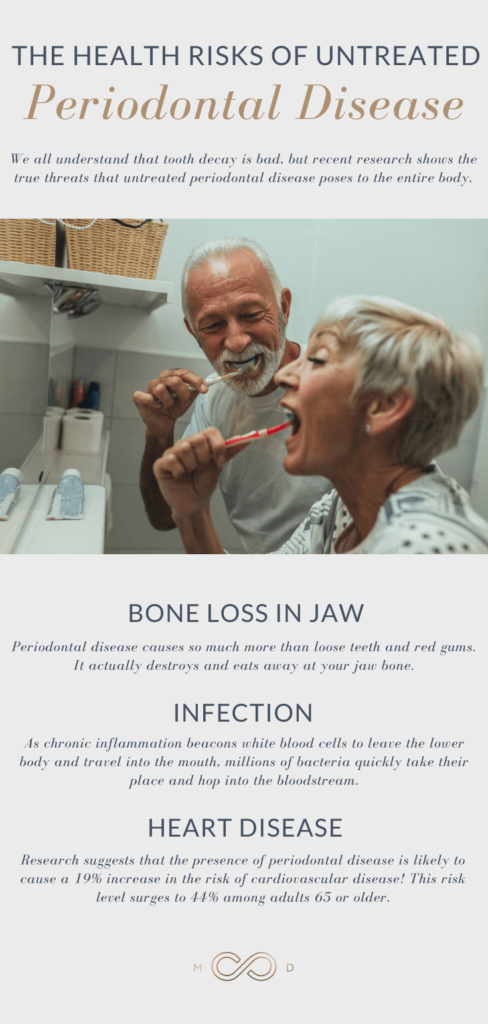What does your health insurance policy cover?
It might pay for the cost of an ambulance ride to the hospital, important vaccinations, and annual physical exams, but what about your dental work? Not a chance.
You can’t hand over your general health insurance card at the dentist’s office. You need a separate dental insurance policy even for the most basic oral care treatments.
Somehow, the concept of “health insurance” ignores everything between your nose and your chin. It views your mouth as a separate entity that doesn’t deserve the privilege of essential medical care. How can that be?
My dear friend, Dr. Tom Nabors, DDS, is here to unpack this backwards way of thinking and help us understand how we managed to get it so wrong for so long.
As an accredited member of the American Academy of Cosmetic Dentistry and Fellow of the Academy of General Dentistry, not to mention the co-founder of our country’s first salivary diagnostic laboratory, Dr. Nabors is a leading expert in oral health.
With his help, we can understand the true mouth-body connection to whole health.
Understanding the Mouth-Body Connection
Total body health has become a major trend recently, but it’s a new development.
“Today we look at whole body health and total body health, but it wasn’t always like that,” Dr. Nabors explains, “For so long, dentistry was excluded from the conversation about health. We look back now and think, well, why is that the case? It’s a body part, it’s not some box unconnected to the body.”
In fact, the mouth is the largest point of entry into the body!
Despite this, Dr. Nabors continues: “We tend to think of that so differently than fingernails or hair or anything else that projects out.”
There’s no other body part that doctors would dare to disregard the way that we’ve long disregarded the mouth.
We’ve all been taught the same Golden Rule of oral care: brush twice a day. And while the importance of brushing can’t be discounted, medical research tells us that brushing alone can’t protect and optimize your health.
It’s the microbiology associated with the mouth, Dr. Nabors explains that is linking your mouth to heart disease, diabetes, sugar control, preterm birth weight.
As a result, when we treat the mouth as just another body part to clean, we miss the most essential link to dangerous, disease-causing inflammation.
Dr. Nabors gives a comparison to this phenomenon that rocks my world.
A person looks clean and fresh after showering, perhaps even a bit healthier. But nobody can see what’s going on under the surface. He might look clean at the moment, but what damage lurks inside?
In other words, even if your teeth look bright and polished after brushing, they don’t tell the full story. Your oral system could still be compromising your whole health.
This statistic drives Dr. Nabors’ point home: In 2012, the CDC found that 50% of all Americans have periodontal disease. Half of the adults in our country are suffering the consequences of this disease, and many of them don’t even realize it. They assume their teeth and gums are “good enough” because they brush.
Brushing and flossing are essential components of hygiene — they can keep your mouth thriving when it’s already healthy. However, hygiene cannot serve as an intervention to periodontal disease. It doesn’t address the real root causes of the problem or stop periodontal disease from harming the rest of your body.
What Exactly is Periodontal Disease?
At its core, periodontal disease is the chronic inflammation and infection of the gum tissue in the mouth. It’s marked by swollen and bleeding gums, loose teeth, bleeding while brushing, bad breath, and pain in its early stages.
Unfortunately, it’s very easy for periodontal disease to develop. More than 800 species of bacteria live within and around your gum tissues, some good and some bad. When the delicate homeostasis between good and bad bacteria falls out of balance — whether through smoking, high sugar intake, hormonal changes, or genetics — your body reacts automatically with inflammation.
Inflammation is an essential part of the body’s natural healing process as it attempts to fight the infection created by oral bacteria. However, if the causes of periodontal disease remain untreated, your body’s inflammatory response never stops. It becomes chronic and ultimately causes severe consequences not just in your mouth, but throughout your body.
 Health Risks of Untreated Periodontal Disease
Health Risks of Untreated Periodontal Disease
We all understand that tooth decay is bad, but only recently has research proven the true threats that untreated periodontal disease poses to the entire body.
You have more to worry about than a discolored smile or sensitive teeth! Periodontal disease has the power to trigger bone loss in the law, widespread infection, heart disease, and other serious consequences.
Bone Loss in Jaw
Periodontal disease causes so much more than loose teeth and red gums. It destroys and eats away at your jaw bone.
“I know it sounds radical, but it’s not!” Dr. Nabors emphasizes. “When we say bone loss, what are we saying? You’re losing the bone of your jaw, which is your head, your face.”
How does this bone loss in jaw happen? Aggressive bacteria combine with the white blood cells signaled by chronic inflammation to break down everything in their path: first connective gum tissue, then the underlying jaw bone and ligaments.
Infection
As chronic inflammation beacons white blood cells to leave the lower body and travel into the mouth, millions of bacteria quickly take their place and hop into the bloodstream. This gives them the dangerous opportunity to travel wherever they want and sow the seeds of infection.
Just think about how quickly those microbes can reach areas of the body where an infection may prove fatal.
“They’re less than two inches from the brain, maybe an inch from the carotid arteries,” says Dr. Nabors. “We would never ignore pneumonia. We would never ignore someone with a urinary tract infection,” he continues.
Yet somehow the infections triggered by periodontal disease don’t receive the urgent treatment seen with other conditions.
Suggesting that just “brushing better” can resolve this issue is wildly misleading. Imagine only treating a diabetic lesion instead of the diabetes itself. You might clear up the lesion temporarily, but the root causes of diabetes and controlled blood sugar are still there, hard at work, ready to create another complication.
Heart Disease
Just 15 years ago, our main emphasis on preventing heart disease was checking cholesterol. But now we understand that oral health plays a crucial role in cardiovascular health as well. Research suggests that the presence of periodontal disease is likely to cause a 19% increase in the risk of cardiovascular disease! This risk level surges to 44% among adults 65 or older.
Though our scientific understanding of the links between heart disease and periodontal disease is always evolving, it’s easy to see how the rapid spread of infection triggered by periodontal disease can affect the heart.
Treatment Options for Periodontal Disease
Nobody wants to endure the complications of untreated periodontal disease. This is why it’s so important to diagnose, treat, and monitor this condition strategically.
Dr. Nabors knows this better than most dentists; he worked with his father for decades to develop the gold standard of diagnostics.
Back in the 1980s, dentists in America had few advanced tools to understand the microbial causative agents of periodontal disease. Meanwhile, Hain Lifescience, a diagnostic company in Nehren, Germany, was performing about 80,000 tests a year using saliva as the diagnostic medium.
“If you think about it, you can tell so much information from saliva,“ explains Dr. Nabors, “It’s not just this liquid that we use to chew food. There’s a lot of data in saliva and it’s easy to get.”
In 1982, Dr. Nabors’ father called Hain Lifescience, asked for more information, and gradually brought the technology to the United States. It was the missing link to measure microbiology that had always been needed to effectively treat periodontal disease.
The first company the Nabors family founded was Advanced Dental Diagnostics to help bring salivary diagnostics into the mainstream, and saliva testing has been used as the gold standard ever since.
When it comes to treating periodontal disease, Dr. Nabors explains his belief system: “I don’t want to treat the mouth any different than a physician would treat the body.”
Careful testing, blood work, evaluation of clinical symptoms, and conversation are all needed to gain a comprehensive understanding of the condition of the mouth.
Despite this, traditional dentistry still only measures anatomical changes rather than the activity of the mouth’s underlying microbiology. As a result, many adults develop severe periodontal disease before anything is even diagnosed!
Dr. Nabors uses a system that ensures every patient he helps receives a personalized treatment plan. No two cases of periodontal disease are identical, so no two treatment plants should be, either.
He begins with a visual exam and supplements his observations with the results of a saliva sample. By combining visual and microbiological evaluations, Dr. Nabors can identify the exact nature of the infection and prescribe the best topical antimicrobial.
Some patients also need an antibiotic to combat deeper systemic infections brought on by periodontal disease. This multi-faceted approach heals and protects the mouth and body alike.
How to Achieve Whole Health Through Oral Hygiene
The body gets sick from time to time, right? It’s unavoidable. You catch the flu or stomach bug, but that doesn’t mean you did something wrong. The same principle applies to your mouth. Your oral cavity can get sick as well; sometimes your choices are the culprit, but other times it’s unavoidable.
Genetics, lifestyle habits, hormones, and many other factors all play their own role in your oral health. In order to achieve whole health and prevent the devastating effects of periodontal disease, begin by finding a dentist who is aware of the mouth-body connection.
You need a dentist who understands that having your teeth cleaned every six months can’t magically prevent periodontal disease or stop bone loss in the jaw. Ask your dentist a few questions to better understand their beliefs and practices regarding periodontal disease:
- How do you handle the mouth-body connection?
- What do you do differently than other dentists?
- Do you measure microbiology?
- What tools do you use, aside from visualization, to assess my oral health?
If this line of questioning reveals that your dentist isn’t prepared to evaluate the microbiology of your mouth then he’s missing half of the equation.
You don’t want a dentist who never thinks outside of box or dares to push the boundaries of medicine. Look for a dentist who feels compelled to treat his job as more than a standard 9 to 5 responsibility.
“Dentists have the power to limit inflammation and improve overall health,” Nabors reminds us.
By connecting with a dentist who appreciates the interconnection between the mouth and the body, you can enhance your longevity and embrace whole health.

Dr. Aaron Wenzel is a concierge physician specializing in the care of fast-moving entrepreneurs, executives, and public figures in the Nashville, TN area. Dr. Wenzel’s diverse life experience and extensive training in family medicine, emergency care, nutrition, and hormone replacement therapies give him the unique platform to provide unmatched care for his patients.






